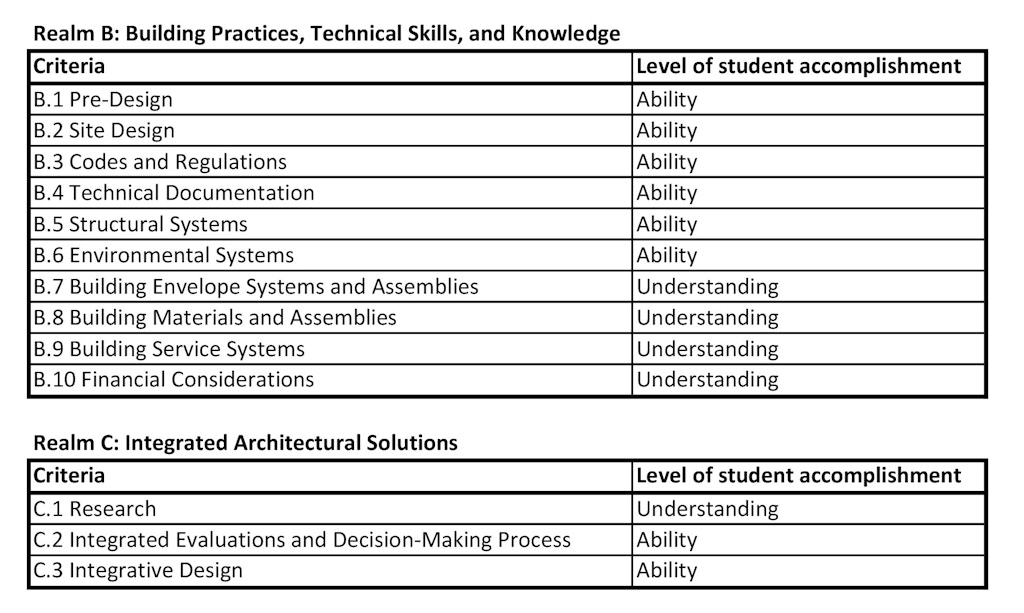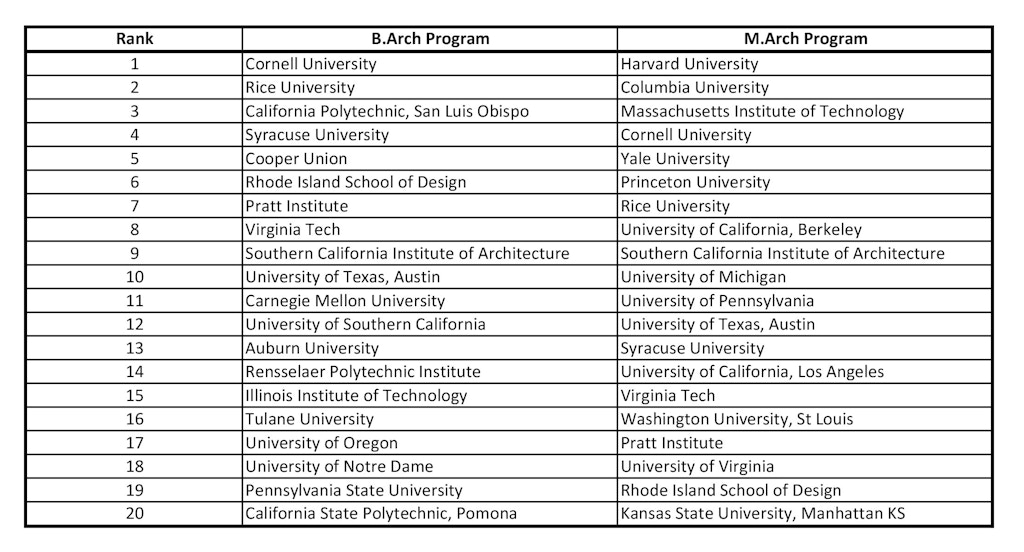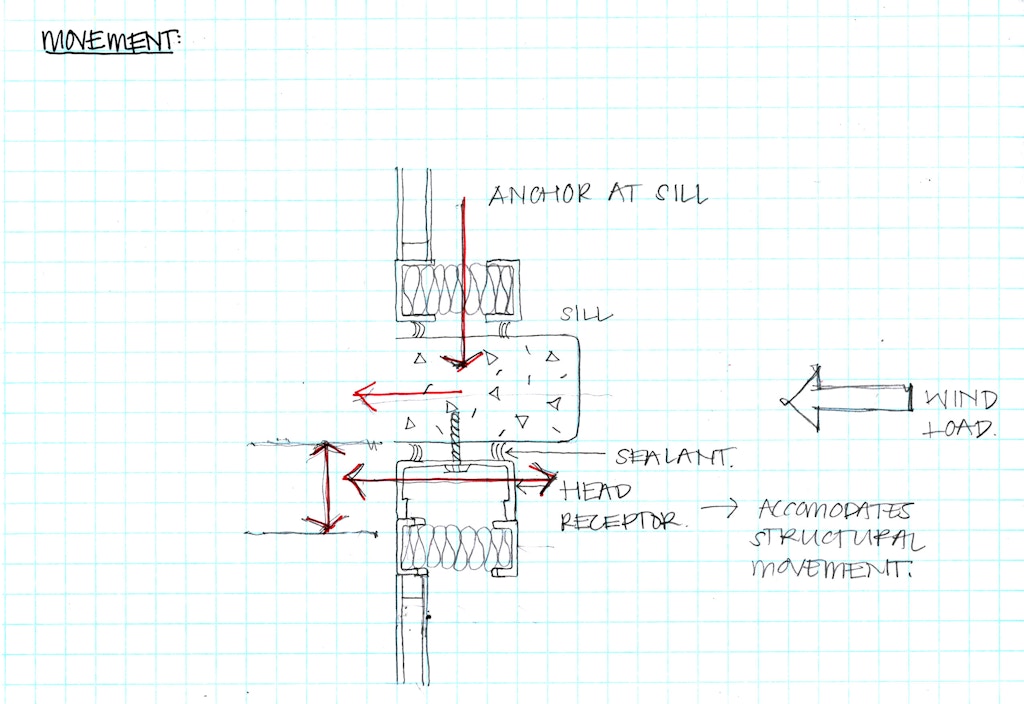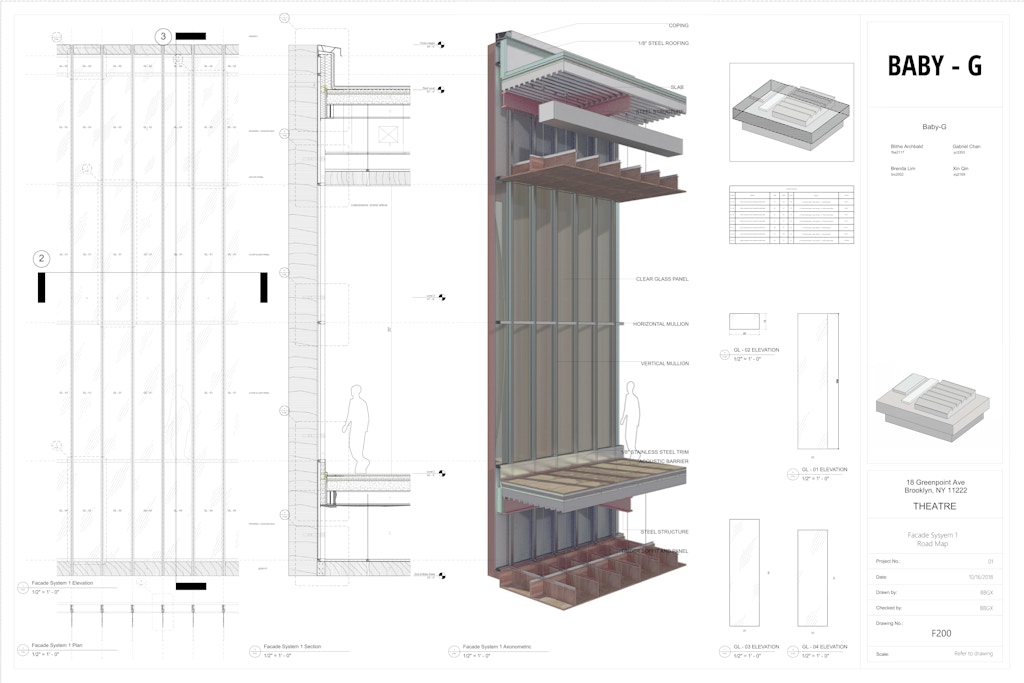Systems Thinking
Teaching Facade Design in Professional Architecture Degree Programs
Presented on August 19, 2020 at Facade Tectonics 2024 World Congress
Sign in and Register
Create an Account
Overview
Abstract
This paper surveys facade design education in accredited Bachelor and Master of Architecture (B.Arch and M.Arch) programs in the United States. A review of accreditation documents from the top 20 B.Arch and 20 M.Arch programs, as ranked by the 2018-19 DesignIntelligence survey, indicated that most schools teach facades as part of lecture courses in materials and construction systems (67%), or through integration studios (58%). Only four programs in this sample (12%) offered standalone lecture courses in building envelopes as part of the core curriculum. This approach – which is influenced by the National Architecture Accreditation Board’s (NAAB’s) Student Performance Criteria – may not adequately prepare students to design building envelopes after graduation.
Architectural design education must address many content areas, including design, construction technology, social equity, and professional practice. In most design-oriented programs in the United States, technical subjects are de-emphasized, and the focus – in terms of credit-hours and school culture – is on design studio courses. However, schools can deliver robust technical education in envelopes in the context of design-oriented professional degree programs. Case studies of two programs where the author teaches demonstrate how a core lecture course, a core technical studio, and advanced electives can be linked to create a three-semester course sequence in envelope design. A strength of both programs is the focus on facade system typologies – as opposed to materials or performance criteria – and the direct link to developing design projects in the studio with the guidance of experienced critics.
Authors

Gabrielle Brainard, AIA, LEED AP, CPHC
Lecturer
Columbia GSAPP
braing@rpi.edu
Keywords
Introduction
Envelope systems are a fundamental part of most architecture projects, with a direct relationship to building aesthetics, environmental performance, and occupant comfort. However, most accredited architecture programs in the United
Access Restricted
Background
NAAB accreditation and Student Performance Criteria
Since 1975, the National Architecture Accrediting Board (NAAB) has accredited professional architecture programs in the United States, including the B.Arch and M.Arch degrees. Because NAAB is the only U.S. accrediting body, and because most state registration boards require a NAAB-accredited degree for licensure, NAAB’s curricular standards have a profound influence on the education of licensed architects in the United States (NAAB, 2015).
While the conditions for accreditation have evolved over time, NAAB has tracked programs’ educational content through a series of Student Performance Criteria (SPCs) since 2004.1 This list, which currently includes over 30 criteria grouped in four educational “realms,” encompasses design, technical, and professional competencies. NAAB does not specify how the criteria are to be met, only that all graduates must demonstrate satisfactory performance, as determined by a peer review of student work. NAAB’s review of student performance only considers the core curricula, in an effort to ensure that “each graduate possesses the knowledge and skills” required for entry into the profession (NAAB, 2014). In this sense, NAAB is defining the minimum competencies required to be a practicing architect.
NAAB identifies two levels of student accomplishment: understanding, defined as “the capacity to classify, compare, summarize, explain, and/or interpret information,” and ability, defined as “accurately applying [information] to the solution of a specific problem” (NAAB, 2014). Of the two, ability is more rigorous: it requires both knowing and doing – the capacity to understand a problem, and the skill to solve it.
The student performance criteria related to facade design address foundational knowledge and design skills. SPC B.7: Building Envelope Systems and Assemblies requires “understanding of the basic principles involved in the appropriate selection and application of building envelope systems relative to fundamental performance, aesthetics, moisture transfer, durability, and energy and material resources” (NAAB, 2014). It is notable that this SPC requires understanding, while the SPCs for other technical subjects – including structural and environmental systems (B.5 and B.6) – require ability (Figure 1). This distinction influences the way these subjects are taught. Core curricula typically include standalone courses in structures and environments, but not in envelopes.
The SPC for Integrative Design (C.3) also relates to the building envelope. This SPC requires the “ability to make design decisions within a complex architectural project while demonstrating broad integration and consideration of environmental stewardship, technical documentation, accessibility, site conditions, life safety, environmental systems, structural systems, and building envelope systems and assemblies” (NAAB, 2014). This SPC – evaluated at the “ability” level – is often met with an “integration” or “design development” studio that engages students in technical design projects, including the detailed design of envelope systems.

Facade education in NAAB-accredited programs
There are 160 NAAB-accredited programs in the United States, including 52 B.Arch programs and 107 M.Arch programs. Accredited programs are located in every region of the country, and in many types of academic institutions (NAAB, 2018). The accreditation process includes a site visit by a team of NAAB volunteers, who prepare a Visiting Team Report (VTR) evaluating whether a program meets the conditions for accreditation. For each SPC, the report includes a list of courses that demonstrate student achievement at the prescribed level. Accreditation documents must be made public, and the latest VTR is often posted on schools’ websites (NAAB, 2015).
Visiting Team Reports from the top 20 B.Arch and M.Arch programs (Figure 2), as ranked by the 2018-19 DesignIntelligence survey, were reviewed to determine how SPC B.7: Building Envelope Systems is met. This annual survey asks firm leaders and hiring managers to identify which NAAB-accredited programs they most admire “for a combination of faculty, programs, culture and student preparation for the profession” (DesignIntelligence Rankings, 2019). While not an objective measure, the rankings are a snapshot of professionals’ view of architecture education, with a focus on how well students are prepared for practice.2
Of the 40 programs surveyed, sufficient data was available for 33 programs. Courses meeting the SPC for building envelopes were classified by type, based on course descriptions found on school websites. Historical course descriptions were used if the curriculum had changed since the last accreditation cycle.

The performance criteria for building envelopes (SPC B.7) was typically met through a lecture course in materials and construction systems (22 of 33 programs, or 67%) or an integration studio (19 of 33 programs, or 58%). Twelve programs (36%) included both types of courses. Only 4 programs (12%) offered standalone courses in building envelopes (Figure 3). Several programs employed innovative teaching methods such as envelope performance simulation, physical prototyping, physical performance testing, and case study analysis.

The lack of standalone courses in building envelopes does not mean that teaching is deficient in this area. Six of the 33 programs surveyed (18%) met NAAB’s building envelope criteria “well” or “with distinction,” while only one program was found lacking. However, lecture courses in materials and construction systems – the most common delivery method for facade education – cover many topics in addition to the building envelope. For example, the Building Materials and Construction Systems course at Virginia Tech covers structural systems, codes, cost, and interior finishes in addition to envelopes (Virginia Tech, 2019). While this type of courses may deliver an “understanding” of facade systems, it is unlikely to provide the depth and rigor of a standalone course in envelope design.
Case Studies
Architectural design education must address many content areas, including design, construction technology, social equity, and professional practice. While design studio courses are at the heart of most NAAB-accredited programs, it is possible to deliver rigorous coursework in building envelopes while meeting the other requirements of a design-oriented professional degree program.
Case studies of two programs where the author teaches – the B.Arch program at Rensselaer Polytechnic Institute (RPI) and the M.Arch program at Columbia Graduate School of Architecture, Preservation and Planning (GSAPP) – illustrate how a core lecture course, a core technical studio, and advanced electives can be linked to form a three-semester sequence in envelopes (Figure 4). This approach exposes all students to envelope design principles via the core courses, and enables interested students to deepen their knowledge of envelopes through specialized electives, which could lead to advanced study or specialized careers in the facade industry.

Core Envelopes Lecture Course
The technical sequence at both schools includes a required lecture course on building envelopes (Materials and Enclosures at RPI; AT III, Envelopes at Columbia), both taught by the author, that covers the fundamental design principles of enclosure systems. Rather than focus on materials or performance criteria, the courses are organized around facade system typologies. Three system types are studied: mass walls, cavity walls, and barrier walls. Each type has its own design principles, which dictate materials, assembly, and performance characteristics. For example, a mass wall is load-bearing and manages water via cycles of wetting and drying, while a cavity wall is non-load-bearing and manages water via an air cavity, membrane, flashing, and weeps. Mastering these principles at a basic level unlocks design patterns that students can adapt to more complex envelope systems in their design projects.
Students in Materials and Enclosures learn these design patterns via self-directed inquiry. They design three facade systems – one for each typology – and describe their systems’ response to performance criteria (such as load, strength, movement, heat, air, and moisture flows) through hand-drawn diagrams (Figure 5). Students bring one of these designs to a higher level of resolution for the final project, constructing large-scale physical models that illustrate materials, assembly, and construction sequence (Figure 6). The experience of working in three dimensions, at large scales, and with real materials informs students’ design work in subsequent studio courses.


Core Integration Studio
Both programs include an integration studio (Integrated Design Development at RPI; AT IV, Building Systems Integration at Columbia) taken prior to or concurrently with the enclosures lecture course. The AT IV course at Columbia, coordinated by Sarrah Khan, is unique in that students work on a standalone technical design project – typically a small institutional building – that is not related to their studio projects. Decoupling the technical and design projects allows students to focus on technical resolution and integration of building systems in AT IV, while exploring the full range of design possibilities in their studio work.
Design and engineering professionals serve as visiting critics in AT IV, where they work with students in desk critiques to guide the technical resolution of their projects. The critic team includes a technical architect, a structural engineer, a mechanical engineer, and a facade specialist. Columbia’s location in New York City allows the course to draw on a large pool of adjunct faculty, who balance teaching with professional practice. The facade critics focus on translating students’ design intent into buildable facade concepts that are documented systematically and clearly (Figure 7). Projects move from design intent to clarification of system types to detail development. The studio model, with its high student-to-faculty ratio and emphasis on desk critiques, enables the students to learn through extensive contact time with experienced practitioners.

Advanced Facade Electives
Both RPI and Columbia offer advanced electives in enclosure design, allowing interested students to deepen their knowledge of envelope systems after taking the core lecture and studio courses. At RPI, the Building Envelopes course, taught by the author, focuses on facade thermal performance. Students consider the mechanics of heat flow through wall assemblies and use 2D thermal modeling to calculate system U-factors and identify thermal bridges. They then select an existing building and propose a facade retrofit that will improve the building’s thermal performance (Figure 8).

The Advanced Curtain Wall course at Columbia, taught by Robert Heintges since 2001, is an intense introduction to the practice of facade engineering. Lectures cover performance criteria, materials, design documentation, specifications, and mockup testing. Students develop detailed drawings and specifications for a curtain wall of their own design, with support from the instructors via desk critiques (GSAPP, 2019).
Many architecture programs offer similar electives related to enclosure design. Some schools offer electives taught by adjunct faculty who are practicing building scientists or facade specialists, such as Andrea Love at Harvard, Charles Berman at the University of Pennsylvania, and Sameer Kumar at Princeton. Other schools, such as the University of Oregon and the University of Southern California, offer specialized courses taught by full-time faculty linked to graduate programs in building science, sustainability, and facade design.
It is important that these electives are linked to strong technical offerings in the core curriculum. Without a background in facade design principles, students may not be prepared for the content of advanced courses. Additionally, only a small subset of students will choose to take these electives, while most students will engage in enclosure design as licensed architects.
Conclusion and Future Work
Case studies of the curricula at RPI and Columbia illustrate the potential of professional degree programs to deliver robust training in facade design while fulfilling the other requirements of design education. At both schools, a three-semester sequence in envelopes was created by adding facade content to the core building technology lecture and studio courses and linking them to specialized electives. Similar opportunities exist in other programs, especially those that already offer advanced electives in facade design. However, the facade design pedagogy in NAAB-accredited programs generally lacks depth. Most programs teach enclosure design as part of a general survey of materials and construction systems, not as a standalone discipline.
Strengthening NAAB criteria related to building enclosures could encourage schools to implement more rigorous coursework. As of this writing, NAAB’s Conditions and Procedures for Accreditation are being updated with input from academics, regulators, and professionals (NAAB, 2019). NAAB’s proposed 2020 Conditions for Accreditation include major changes aimed at giving schools greater flexibility. Student Performance Criteria have been replaced by Program and Student Criteria, and multiple SPCs related to building technology have been consolidated into one criterion, SC.4 Technical Knowledge, evaluated at the understanding level (NAAB, 2019).3 The impact of these changes on building technology curricula is unclear. Loosening NAAB’s prescriptive requirements could allow schools to develop more focused technical coursework, or it could allow schools to further de-emphasize courses in building technology.4
Early exposure to the fundamentals of enclosure design prepares students to be competent architects, and may create opportunities for students to pursue advanced study or specialist careers in the facade industry. Anecdotal evidence suggests that when students encounter facade design as part of a professional degree program, it can impact their career trajectories, including inspiring some to pursue facade specializations. Avenues for future research may include surveys of students and recent graduates to gauge the impact that early exposure to facade design education has on their career outcomes.
Footnotes
-
NAAB’s proposed updates to the 2020 Conditions and Procedures for Accreditation include significant changes to the SPCs, discussed in the conclusion to this paper (NAAB, 2019).
↩︎ -
General rankings (as opposed to rankings in focus areas) were considered to reflect the preparedness of a typical architecture student to engage in envelope design.
↩︎ -
SC.4 Technical Knowledge addresses “how the program prepares students to understand the established and emerging systems, technologies, and assemblies of building construction, and the criteria architects use to assess those technologies against the design and performance objectives of projects.” SC.6 Building Integration also addresses building envelope systems, and is evaluated at the ability level (NAAB, 2019).
↩︎ -
The AIA Committee on the Environment (COTE) expressed such concerns with regard to coursework addressing climate change. In their comments on “Draft 0” of the 2020 Conditions, COTE members noted that “we are concerned that the more flexible approach to accreditation will limit the amount of climate related instruction in some schools” (AIA COTE, 2019, emphasis in original).
↩︎
Acknowledgements
The author would like to acknowledge the instructors and co-instructors of the courses mentioned in this article, including Lonn Combs at RPI and Sarrah Khan and Robert Heintges and Dan Vos at Columbia GSAPP. Thanks also to Demetrios Comodromos and Craig Schwitter for sharing their experiences coordinating the building science and technology sequences at RPI and Columbia, respectively.
Rights and Permissions
AIA Committee on the Environment (COTE). “Comments on the Draft 0 NAAB 2020 Conditions for Accreditation.” 9 July 2019.
Columbia University Graduate School of Architecture, Planning and Preservation (GSAPP). “A4634-1: Advanced Curtain Wall.” arch.columbia.edu/courses/12035-2285. Accessed November 17, 2019.
DesignIntelligence Rankings. “DesignIntelligence Research Methodology.” www.di-rankings.com/methodology/. Accessed November 17, 2019.
DesignIntelligence Rankings. “Most Admired Architecture Schools.” www.di-rankings.com/most-admired-schools-architecture/. Accessed November 17, 2019.
The National Architecture Accrediting Board (NAAB). 2014 NAAB Conditions for Accreditation. Washington: NAAB, 2014.
The National Architecture Accrediting Board (NAAB). 2018 Annual Report on Architectural Education. NAAB, 2018.
The National Architecture Accrediting Board (NAAB). “ARForum19.” NAAB, www.naab.org/arforum19/. Accessed November 17, 2019.
The National Architecture Accrediting Board (NAAB). 2020 NAAB Conditions for Accreditation “Draft 1.” Washington: NAAB, September 9, 2019.
Virginia Tech School of Architecture and Design. “Arch 5565, 5566: Building Materials and Construction.” archdesign.caus.vt.edu/courses/arch-5565-5566/. Accessed November 17, 2019.